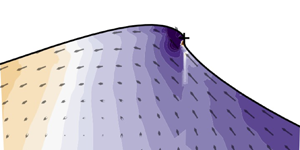Article contents
An energetic signature for breaking inception in surface gravity waves
Published online by Cambridge University Press: 23 March 2023
Abstract

A dynamical understanding of the physical process of surface gravity wave breaking remains an unresolved problem in fluid dynamics. Conceptually, breaking can be described by inception and onset, where breaking inception is the initiation of unknown irreversible processes within a wave crest that precede the visible manifestation of breaking onset. In the search for an energetic indicator of breaking inception, we use an ensemble of non-breaking and breaking crests evolving within unsteady wave packets simulated in a numerical wave tank to investigate the evolution of each term in the kinetic energy balance equation. We observe that breaking onset is preceded by around one quarter of a wave period by a rapid increase in the rate of convergence of kinetic energy that triggers an irreversible acceleration of the kinetic energy growth rate. This energetic signature, which is present only for crests that subsequently break, arises when the kinetic energy growth rate exceeds a critical threshold. At this point the additional kinetic energy convergence cannot be offset by converting excess kinetic energy to potential energy or by dissipation through friction. Our results suggest that the ratio of the leading terms of the kinetic energy balance equation at the time of this energetic signature is proportional to the strength of the breaking crest. Hence this energetic inception point both predicts the occurrence of breaking onset and indicates the strength of the breaking event.
- Type
- JFM Papers
- Information
- Copyright
- © The Author(s), 2023. Published by Cambridge University Press
References
- 1
- Cited by





